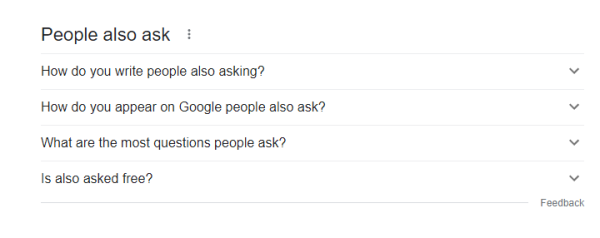No products in the cart.
SEO
People Also Search For Or People Also Ask (SEO Advantages)
Summary
Since Google is constantly updating its algorithm to deliver the best possible results for its users searches, for SEO professionals, this is a game changer when it comes to getting the best results for targeted keywords. The “People Also Search For” and “People Also Ask” (PASF and PAA, respectively) boxes have evolved over time and have become a world of possibilities for keyword exploration, so now you have to take advantage of this.
With this guide, you’ll learn in depth everything you need to know about this topic, starting with knowing what the PASF and PAA boxes are, how they work, how to use them to extract keywords, as well as tips and tools to optimize your content to take advantage of these Google features.
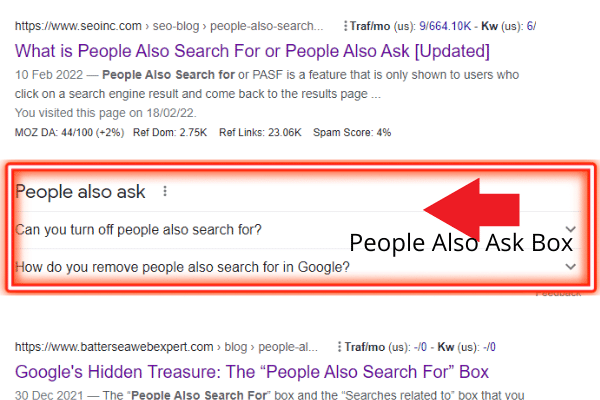
What is People Also Search For on Google?
PASF is a feature of Google’s search engine that appears to users under certain conditions to improve their experience when performing their searches. If a user doesn’t immediately find content related to his search terms, Google will offer a series of related phrases or words in the form of suggestions to help the user obtain the information he’s looking for. The goal behind this feature is to satisfy the User Intent as accurately as possible.
How do you see what people also searched for?
PASF is displayed to the user when this, after performing a search and clicking on a result – usually one of the top five in the page – bounces back and quickly returns to the Search Results Page (SERP). Keywords related to user intent appear in a small box titled “People Also Search For” and act as Google suggestions of terms related to the search, that other people have also searched for and that the first user probably hasn’t thought of. Currently, the PASF suggestion box appears below the top results on the SERP page.
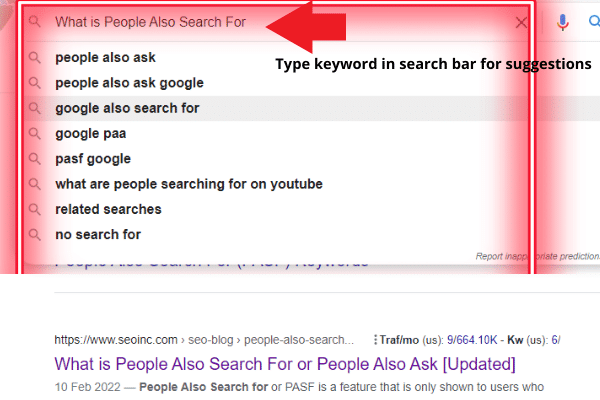
How do you search for keywords on Google?
There are several methods that you can use to search for keywords on Google for free when you can’t or don’t want to invest in some expensive professional tool for this purpose – although naturally, the accuracy won’t be the same as with a professional tool.
- Search Box (Google Predictions) – The easiest method is to start typing in the Google search box so that it begins to offer you a series of words or phrases related to your search. These Google Suggestions are based on words and phrases that other people use frequently, so it’s a great place to get an idea about what people are searching for on the Internet.
- Related searches – This is a series of search terms that Google displays on the results page after clicking on the “Search” button. This set of phrases appears right at the bottom of the results page under the heading “Searches related to [keyword]” and offers up to 8 phrases related to the search term.
All these phrases are usually related to each other, since they are based on user intent. Here you can also find interesting ideas related to your keywords that other users have searched for.
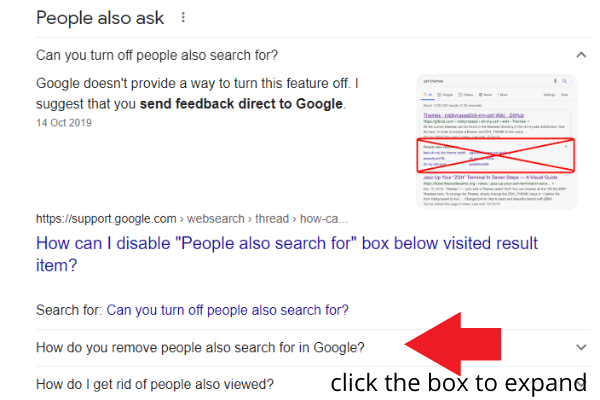
How do you scrape People Also Ask?
“People Also Ask” is a Google suggestion box in the form of a set of questions related to your search term. Each question is a link to a website that contains the answer to the respective question, so it can be an important source of keyword ideas. Here are a couple of methods you can use to get all the information you want from this Google feature.
- Manual method – Each time you click on one of these questions in the form of a dropdown text in the PAA box, you will see how it expands and a short text appears with the answer to the question. If you click on the dropdown text again, it’ll close and you’ll see how new related questions appear at the bottom of the box. Continue clicking on these buttons to get all the related questions.
- Automatic method – An easier and faster way to scrape the contents of the PAA box is to use a free tool like “Scraper Chrome extension.” You just have to go to the Chrome store, search for the extension, install it in your browser and activate it.
To use Scraper Chrome extension, you just have to do a Google search to bring up the PAA box, click on all the questions you want to scrape and click the “Scrape” button to get all the content related to the question you chose.
What is the difference between People Also Search For and People Also Ask?
Both PASF and PAA boxes are features that Google uses to offer its users additional results relevant to their searches. However, both features basically offer the same information, with a different format and presentation, but always related to user intent. All this must be considered when taking advantage of these tools.
While the PASF box presents raw phrases – just as a somewhat hasty user would type them – right after bouncing off one of the results offered in the SERP, the PAA box appears almost every time any type of search is performed, and it does so as a series of questions formulated in a higher quality format.
For example, for a search like: “Do I need to hire a car accident lawyer?” the format offered by each box would be:
- PASF: “best car accident lawyer”
- PAA: “How much does a lawyer charge for a car accident?”
For SEO professionals, the key is to know how to take advantage of the characteristics of each box to obtain the broadest possible vision regarding their marketing goals.
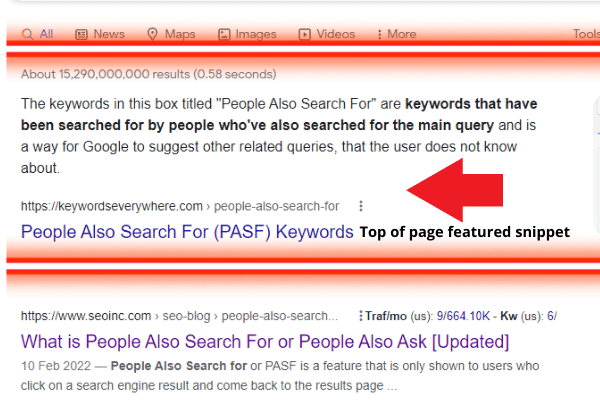
Using PAFS for your SEO Advantage
Now that you know how the PASF box works and how it differs from other similar Google features, let’s look at some tips to get the most out of it.
1.- User intent
User intent indicates the reasoning behind the user search, based on the keywords or phrases used. In this sense, if a user types the word “climate”, Google can return results related to “climate change” or “weather forecast”, for example. In this way, Google uses other words and phrases related to the main keyword to determine the user search intent and thus return the best possible result. This means that in order to create quality content around a keyword, you should consider helping Google to easily distinguish the context related to that keyword.
2.- What are featured snippets and how do they help take a note of related queries?
Featured snippets are boxes that appear in the Google’s SERP showing content that is very specific to user intent. These boxes usually appear in the first position of the results just below ads and any paid content – if any exists.
Google places as a “featured snippet” any content that it considers to be high-quality and that satisfies user intent to a high degree. The more specific the search phrase, the better for content to appear as a featured snippet on Google. Featured snippets can be very useful for creating content around the question it is trying to answer, but they are even rarer than PASF and PAA boxes.
3.- Getting more featured snippets
In order to win a featured snippet from Google, the key is to create and structure your website and content in the right way. Let’s see how to do this.
3.1.- Create content that answers questions
Creating content in the form of questions that include your target keywords, as well as the best possible answer to that question, is the best way to increase your chances of winning a featured snippet. The idea then is that you dig deep to find out what people are asking on Google and think of a way to structure quality content around these questions.
A good example of the previous idea would be if instead of targeting the seed phrase “content marketing”, you go into the long-tail and include “how does content marketing work?”. Remember that you can get free ideas from the Google search box.
3.2.- Create high-quality content
For content to win a featured snippet, it is also important that the first one is high-quality and meets all the positioning factors that Google reviews. This means that your content must be well structured, easy to understand, entertaining and directly answer the user question.
This last aspect is of special relevance, since you shouldn’t only answer the question short, quickly and precisely from the beginning, but you should also add as much additional content as you can to satisfy the users if they want to delve deeper into the topic. The higher quality you offer, the more chances of winning that desired featured snippet and ranking high in Google.
3.3.- Use Q&A pages
Question and answer pages allow you to offer additional value to your users and at the same time increase the chances that your content will win a featured snippet. In these types of pages, the most important factors are to answer as many questions related to user intent as possible, but also to do it in the most complete way and with the appropriate format. You can also add links to the content of these questions and answers to provide better context if you feel it’s necessary.
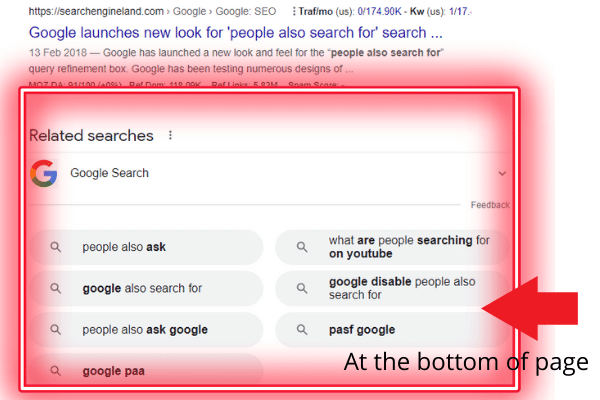
4.- Create content around People Also Search For and related queries
Try to study as much as you can all the content related to PASF boxes. Think of topics directly related to your main topic or keyword and expand your search using the PASF, PAA and other related queries boxes. This will help you expand your content and its quality, with the consequent improvement in Google rankings.
The more content related to your keywords and phrases you have, the more likely it is that your content will appear as the first additional alternative to the first results that the user visits in case he bounces back.
5.- Optimize your content for PAFS
Research all topics related to your keywords and user intent. For this, you must put yourself in the place of users and understand what they are looking for. Remember to use all the features that Google offers you to identify relevant keywords, in all available formats.
Structure your content in such a way that all that valuable information fits perfectly and naturally within your content. Add links, Tip boxes, FAQ sections, Q&A pages and anything else you can think of. Another good idea is to create a pillar page that deals with the main theme and add cluster nodes to expand the information in an orderly and elegant way.
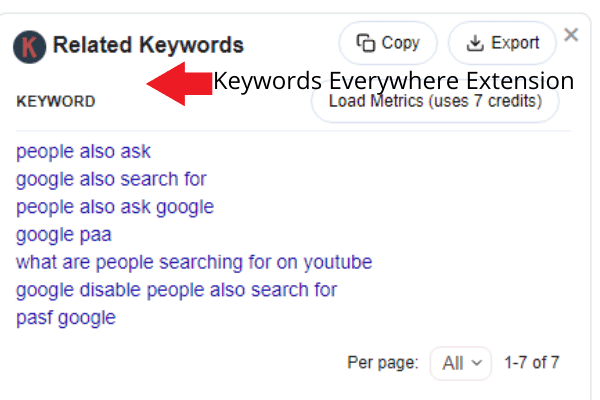
6.- Use these tools to find the PAFS keywords
6.1- Keywords Everywhere
This is a tool that comes as an add-on for Google Chrome and other browsers that works very well to find keywords related to PASF. In a nutshell, the tool offers data from PASF boxes along with some pretty useful usage statistics, such as search volume, competition, most used devices, and more. The tool is free to use, but it offers additional features that you can purchase if you feel you need them.
6.2.- Ahrefs
Ahrefs is one of the most popular keyword research tools. It comes with an attractive user interface and works by offering keyword suggestions relevant to your target keyword. The tool has a huge database with more than 5.1 billion keywords from almost 200 countries. An important aspect of Ahrefs is that it allows you to obtain valuable information about the keyword strategies of your competitors and compare your arsenal against theirs to try to gain an advantage. The problem is that most likely, your competitors will also be doing the same.
Conclusion
If you want to take advantage of PASF, PAA and similar boxes to improve your keyword arsenal, the best strategy is to learn how to combine all the valuable information that these Google features provide to enrich your content as much as possible. There is no reason to prefer one over the other, as all of these tools are extremely useful.
Remember that expanding your content to offer the best possible experience to your prospects is one of the best ways to build authority in your niche and achieve a better position in Google’s organic results. It takes some time, but it works and is well worth it in the long run.
For more information on how you can improve your content strategy, take a look at how to do SEO for a website to increase your traffic online.

